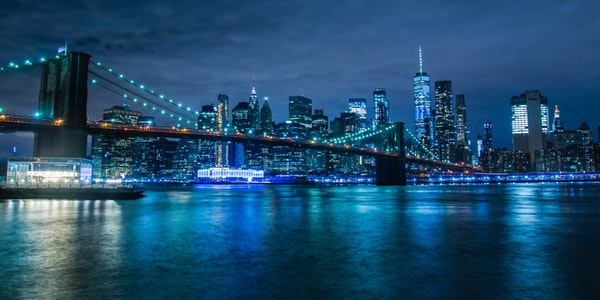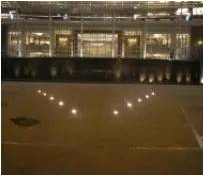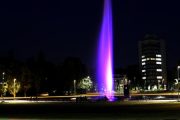Underground Lights
1, the Scope of Application
Landscape structures, sketches, plants, hard pavement lighting.
It is mainly arranged in hard pavement lighting facades, lawn area lighting trees, etc. It is not suitable to be arranged in shrub areas lighting trees and facades, so that the light will form too many shadows and dark areas.
Buried lights should not be arranged in hard or lawn low water level or drainage areas, because the accumulated water after rain will cover the lamp body. When the buried lights are arranged in the lawn area (not in the area where people often move), the glass surface should be about 125px cm higher than the lawn surface, so that the glass surface will not be submerged by the water after rain.
2, Selection Requirements
Light Color
Problem: The noisy and false color light is not suitable for the use of the night scene environment of human settlements.
Requirements: For a livable lighting environment, natural color temperature range (2000-6500K color temperature selection) should be adopted. Adjust the color temperature of the light accordingly according to the color of the plant. For example, the color temperature of 4200K should be used for evergreen plants, and 3000K for red-leaf plants.
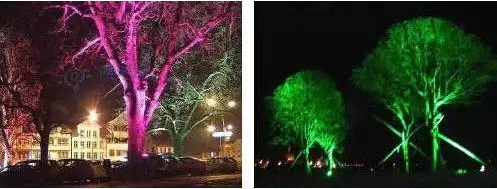
Light Form
Question: Plant lighting should be in the form of mud lamps or ground lamps. The scattered lights scattered in various areas of the green belt will seriously affect the daylight landscape of the green belt.
Requirements: Under the premise of not affecting the growth of plants and causing damage to the planting soil ball and root system, the trees in the lawn area should be illuminated with adjustable-angle buried lights.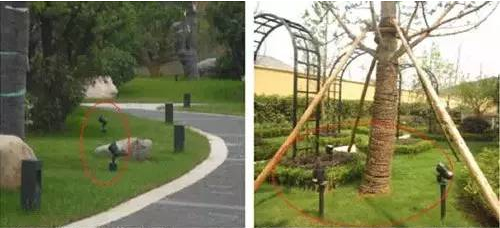
The choice of buried lights varies according to the different plants to be illuminated. In the case of sparsely branched trees, a set of underground lamps are arranged at the roots to direct narrow light. For lush tall trees, one or two sets of polarized buried lights can be arranged at a distance of about 3 meters from the trunk. Spherical shrubs are suitable for arranging wide-light type or astigmatism type lamps with internal penetration. Crown asymmetrical trees are illuminated by a set of adjustable-angle buried lights.
Light Craft:
Buried lights without chamfering at the edges:
Problem: If the lamp installed on the hard pavement has no chamfer and the lamp cover is higher than the pavement surface, it is easy to stom on the feet of pedestrians.
Buried lights with chamfering treatment:
Requirements: Choose a buried lamp with a chamfered lamp cover, and seal the edges of the lamp with waterproof glue or glass glue after installation.
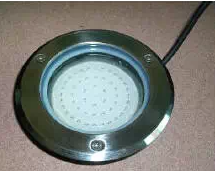
Glare
All lighting-type underground lights (higher power, lighting facades, plants) need to have anti-glare measures. Such as the installation of light-controlling grids, adjustable lighting angles of lamps, and the use of asymmetric reflectors in the lamps.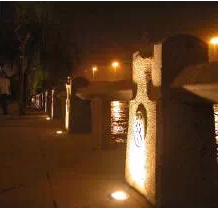
The effect of glare of illuminated underground lights
The glare effect of decorative buried lights
The translucent surface of all decorative underground lamps (with low power, for guiding and embellishment) needs to be frosted. The beam is wide, and there is no obvious light source.
3, installation process
No embedded parts placed
Problem: The buried lamp is directly buried in the lawn without the embedded parts, and the wiring part is directly buried in the ground. At the same time, there is no gravel permeable layer and sand absorbent layer under the buried lamp. If the water accumulates after the rain, it will cause electrical conductivity or Short circuit phenomenon.
The luminaire is directly buried on the hard pavement without the embedded parts, and the luminaire adopts the aluminum lamp body, which exceeds the diameter of the paving opening after thermal expansion and contraction, and expands and arches out of the ground, resulting in uneven ground.
Requirements: Standard installation, using embedded parts. The hard pavement opening is slightly larger than the diameter of the lamp body, but smaller than the outer diameter of the steel ring.
Water vapor entering phenomenon:
Problem: Due to the thermal expansion and contraction of the air in the lamp cavity, the outdoor atmospheric pressure presses the moist air into the lamp cavity, which will cause the lamp tube to burst or short circuit trip.
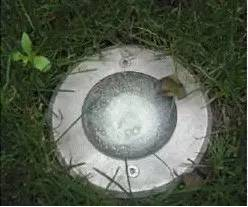
Correct installation method:
1) During the sample delivery process, the waterproof level of the lamp must be tested to ensure that it reaches IP67 or higher. Method: Put the buried lamp in the water basin, the water surface is at least about 5cm above the glass surface. Power-on trial operation for 48 hours. During this period, the opening and closing actions are about six times every two hours to check the waterproof condition under the heated and cooled state.
2) Seal the wire connections well. Generally, the connection port of the underground lamp has a special sealing rubber ring and a stainless steel fastener. First pass the cable through the rubber ring, and then tighten the stainless steel fastener until the wire cannot be pulled out of the sealing rubber ring. At the same time, a waterproof junction box must be used when connecting the incoming line and the lead. After the wiring is completed, the edge of the junction box is glued and sealed or the inside is filled with wax.
3) Do a good job of underground seepage treatment during construction. For the buried lights arranged in the lawn area, trapezoidal column-shaped embedded parts with a small upper mouth and a large lower mouth should be adopted. For hard areas, barrel-shaped embedded parts should be used, and a permeable layer of gravel and sand should be made under each buried lamp during installation.
4) After the buried lamp is installed, open the cover and cover it after lighting for half an hour to keep the inner cavity of the lamp in a certain vacuum state, and use the outdoor atmospheric pressure to press the lamp cover sealing ring.
Ground plug light (spotlight)
1, the scope of application
It needs to be arranged in the shrub area to illuminate the trees. The lamps should be effectively concealed in the bushes, and the light-emitting port should be about 10cm higher than the bushes.
2. Requirements for lamp style selection
Considering the daytime landscape, it is recommended to use as few as possible ground plug-in spotlights in the lawn area. The lamps are arranged irregularly on the green vegetation, forming black spots in the green environment. Excessive glare spots will be formed at night, which will affect the comfort of night lighting.
Requirements: If you need directional projection light effects, use adjustable-angle buried lights instead. Or use decorative objects that match the landscape to cover it.
If there is no need for directional projection, use ordinary buried lights instead, and install anti-glare grilles as needed.
3, installation process
Fixing process
Advantages: convenient installation, suitable for general projects with abnormal construction period.
Problem: The structure of the ground plug light fixture determines that it cannot be firmly fixed. It’s crooked when you touch it, and you pull it out. It is easy to suffer damage, but also has safety hazards.
Requirement: Replace with underground lights. If you must illuminate in the form of ground plug lights, it is recommended to replace adjustable lamps with a base. The base is fixed by pouring concrete on the foundation, and the wires are connected in parallel in the bottom seat.
Wiring process
Problem: The cable and the lead of the lamp are directly thrown on the green belt without any protection, and they are directly handled in parallel. If the ground water accumulates, it will cause leakage and short circuit, which will cause serious safety hazards.
Correct installation method
(1) If the power cord is protected by a steel pipe, the lead should be protected by a metal hose, and the connection should be protected by a waterproof junction box. After the wiring is completed, glue or wax the edge of the waterproof junction box, bury it in the soil, and place appropriate gravel underneath. (Good waterproof, high cost, relatively complicated process).
(2) If the power cord is protected by PE or PVC, the lead is protected by a plastic hose, and the wiring is protected by a plastic junction box, buried in the soil, and appropriately gravel under it. This approach is less waterproof, but it is less expensive and easy to install.
(3) If the construction period is tight or it is impossible to avoid the exposed joints, five layers of waterproof glue-insulating glue-waterproof glue-insulating glue-waterproof glue should be alternately protected when connecting. The connector faces upwards and must not be placed on the ground or underground. Keep the joints out of the ground water to prevent leakage and conduction (exposed joints should be controlled in the bush area out of reach)
Each project can select the appropriate process according to the cost control requirements and the construction period requirements.
Appearance color and point position
Generally, the on-site mud lamp is black, but the actual installation effect of the lamp is between the lawn and shrubs, which seriously affects the green landscape. If it cannot be replaced with a buried lamp, the surface of the lamp can be treated with a dark green electrostatic spraying process.
point position:
The current lighting design generally uses two sets of mud lamps for sub-arbors, and three to four sets of mud lamps for tall trees. This causes too many glare spots, and at the same time produces direct light for pedestrians’ vision when walking along the route at night. It is required to illuminate the sub-arbor with a set of underground lights suitable for the beam, and to illuminate the tall arbor with two sets of underground lights. (The leafy type is illuminated by a medium beam, and the branch type is illuminated by a narrow beam).
(To Be continued)

